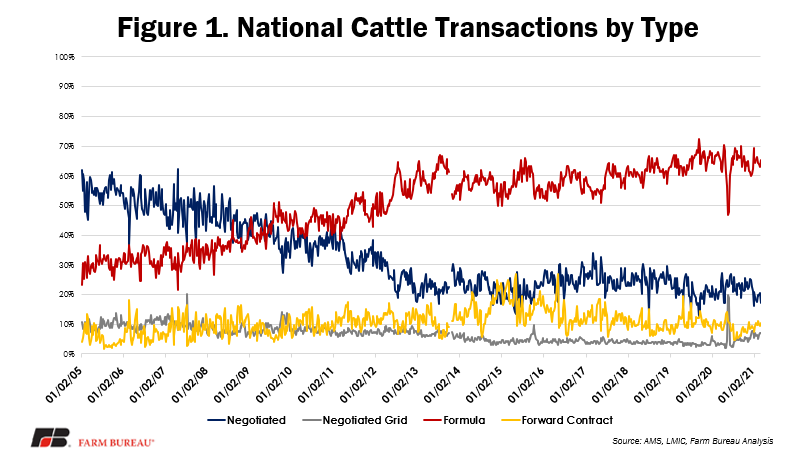New Legislation on Cattle Market Transparency Introduced
TOPICS
Market IntelMichael Nepveux
Former AFBF Economist

photo credit: AFBF
Michael Nepveux
Former AFBF Economist
On Tuesday, March 2, U.S. Sens. Deb Fischer and Ron Wyden introduced the Cattle Market Transparency Act of 2021. The bill focuses on ensuring robust regionally negotiated cash trade and providing producers with more pricing information. This bill would work to establish regional mandatory minimum levels of negotiated trade, as well as mandate new reporting requirements and address confidentiality guidelines in Livestock Mandatory Reporting. The bill aligns with the goals set forth last year by the American Farm Bureau Federation’s Cattle Market Working Group, as well as new cattle marketing policy passed by AFBF’s voting delegates at the 102nd Annual Convention in January.
Provisions in the Bill
The Cattle Market Transparency Act aims to improve price discovery by creating new reporting requirements and providing producers with additional information going into negotiations by mandating the creation and maintenance of a library of marketing contracts offered by packers to producers. USDA already maintains a swine contract library, which has a catalog of the types of contracts offered by packers to swine producers for the purchase of swine (including swine that are purchased for future delivery). USDA’s Swine Contract Library is intended to aid in the price discovery process and provide equal access to market information for all market participants. This legislation would provide cattle producers valuable information on certain contract provisions already utilized in the marketplace and position them to be better able to negotiate a more favorable contract with a packer.
The bill would also mandate daily reporting by packers on the number of cattle scheduled to be delivered for slaughter for the next 14 days. Similar to the contract library provision, this requirement already exists in the swine industry and has proven valuable to producers. The aim of this provision is to aid producers in the industry by creating more accurate forecasts for estimated slaughter numbers, anticipating a packer’s future needs for animals, and as a result, better evaluating supply and demand conditions in the marketplace.
Background on Cattle Transactions
There are a variety of market transactions through which cattle are marketed in the U.S. Thankfully, due to Livestock Mandatory Reporting data, we are able to understand how these animals change hands and how these methods have evolved over time. There are four primary transaction types reported by USDA through LMR.
Negotiated purchases, often referred to as the “spot” or “cash” market, are purchases for which the price is determined through buyer and seller interaction on the day of sale. Forward contract purchases are agreements for the purchase of cattle executed in advance of slaughter; the base price is established in the agreement. With negotiated grid purchases, the base price is negotiated between buyer and seller and is known at the time the agreement is made but the final price is determined by applying a series of premiums and discounts based on carcass performance after slaughter. Formula purchases are the advance commitments of cattle for slaughter by any means other than negotiated, negotiated grid or forward contract. Importantly, formula pricing uses a pricing mechanism in which the price is often not known until a future date.

Over the past 15 years, we have seen a dramatic shift in the way cattle are marketed. In the mid-2000s, roughly 50% to 60% of cattle sold went through the negotiated market. Over time, this method of marketing fed cattle declined and has been replaced by formula transactions. The negotiated market has fallen from half or more of cattle transactions to roughly 20%. At the same time, formula transactions have increased from roughly 30% of transactions to 60% to 70%. Over the same period, we have seen a slight decline in negotiated grid transactions and a fluctuating volume of forward contract transactions.
Regional Minimum Negotiated Trade
It is also important to understand that types of transactions vary by market regionally. Negotiated trade is more common in certain states, such as Nebraska, which have seen its negotiated percentage range from 30% to 60% in recent years. Other states typically have very little negotiated trade. In Texas and Oklahoma, for example, negotiated trade accounts for only 5% to 8% of cattle transactions. These regional variations contrast with the national percentage of negotiated trade, which falls around 20% to 23%. As a result of the differences in agricultural practices between regions, it is important that any attempts to federally mandate a specific level of negotiated trade take into account regional differences; a “one-size-fits-all” approach will not work across all regions of the country.
AFBF policy (updated in January 2021) supports:
“Increasing the share of negotiated sales in fed cattle markets with a central focus on providing price transparency. Any government effort to increase the amount of negotiated sales should be respectful of regional differences. Any marketing requirements should be reviewed or sunset to allow for a thorough cost-benefit analysis”
The Cattle Market Transparency Act would require the Secretary to establish “regional mandatory minimums for the purpose of enhancing price discovery and transparency for cattle market participants.” In developing these thresholds, the bill directs the Secretary to consider the number of packers in the reporting region, the availability of cattle in the reporting region, preexisting contractual arrangements of packers in the reporting region and the number of pricing transactions in the reporting region. The bill would mandate that the initial requirement for the regional mandatory minimums be greater than the three-year average percentage of the negotiated and negotiated grid purchases for the individual regions. These requirements would be subject to a review every two years under consultation with USDA’s Office of the Chief Economist. The bill would also require that within three years of enactment, USDA conduct a data-driven cost-benefit analysis regarding the operation and effect of the regional mandatory minimums.
Summary
The Cattle Market Transparency Act would work to establish regional mandatory minimum levels of negotiated trade, as well as require new reporting requirements and address confidentiality guidelines in Livestock Mandatory Reporting. The bill aligns with the goals set forth by last year’s AFBF Cattle Market Working Group, as well as new cattle marketing policy passed at AFBF’s Convention in January.
Top Issues
VIEW ALL